Dewa Sanzen: 9/12-13/2007
Mt Haguro, Mt Gassan, Mt YodonoJapan
Japan has a rich history of mountain worship, one intertwined with later spiritual ideas that came into the area. Many ideas of Shinto, the native beliefs of Japan, were mixed with Buddhism when it arrived. A major event in this, are the Ideas of Prince Hachico. He believed that Buddha had come to Japan in the forms of Shinto Deities. And many of these deities were/are mountains. The practice of Shugendo Buddhism developed, let by the Yamabushi. Yamabushi literally means, "one who lies in the mountains". These devoted mountain ascetics practice severe austerities in search of personal transformation and supernatural power.
In 7th century, the imperial Prince Hachiko renounced his title and position, took the name Kokai, and became a wandering mountain hermit. While on a beach, he saw an enormous black bird with three legs who led him first to Mt Haguro, and then to the other peaks of the Dewa Sanzen. Kokai stayed the rest of his life upon Haguro-san, where his imperial grave is maintained to this day. Haguro-san is the seat of one of the two main Shugendo orders. On the summit are a massive and beautiful temple,  a great bell, and a sematary, among other things, and along the path up are many shrines and standing stones.
a great bell, and a sematary, among other things, and along the path up are many shrines and standing stones.
The traditional foot path to the summit of Haguro san passes through forest of ancient cedars and cryptomerias and ascending 2446 stone steps. 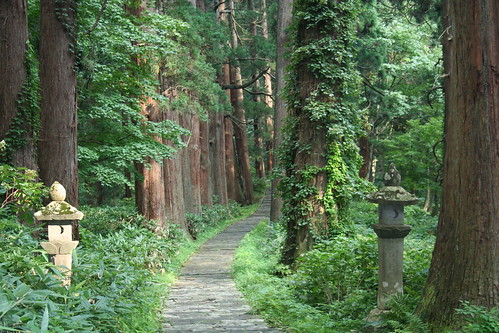 On the top is the shrine of Gassai-den which houses the deities of the tree mountains: Tsukiyomi-no-Mikoto, Oyamatsumi-no-Mikoto, and Ideha-no-Mikoto. The deity of Yudono lives, not in a building, but in a hot water fall. Pilgrims take off their shoes and bathe in the sacred water.
On the top is the shrine of Gassai-den which houses the deities of the tree mountains: Tsukiyomi-no-Mikoto, Oyamatsumi-no-Mikoto, and Ideha-no-Mikoto. The deity of Yudono lives, not in a building, but in a hot water fall. Pilgrims take off their shoes and bathe in the sacred water.
 On the top is the shrine of Gassai-den which houses the deities of the tree mountains: Tsukiyomi-no-Mikoto, Oyamatsumi-no-Mikoto, and Ideha-no-Mikoto. The deity of Yudono lives, not in a building, but in a hot water fall. Pilgrims take off their shoes and bathe in the sacred water.
On the top is the shrine of Gassai-den which houses the deities of the tree mountains: Tsukiyomi-no-Mikoto, Oyamatsumi-no-Mikoto, and Ideha-no-Mikoto. The deity of Yudono lives, not in a building, but in a hot water fall. Pilgrims take off their shoes and bathe in the sacred water.It is said that white clad pilgrims with wooden staffs, sandals, and straw hats can be seen climbing these mountains. And, they say you can occasionally come across a Yamabushi, with conch shell, check jacket, and white pantaloons, sitting under icy waterfall or doing other exercises intended to train both body and spirit, but we didn't see any of this. We did see some old ladies carrying wooden staffs with flags on the top, but that is as far as it went.

From the town of Tsuruoka, in the Yamagata-Ken prefecture, we caught a morning bus to the base of Haguro-san. We had a cup of tea, then passed through the first Torii and into the peaceful forest staircase. Beautiful old Cedar trees lined the granite steps up the slope. We passed a waterfall, and stopped to pour the cold water over our heads, before continuing up.
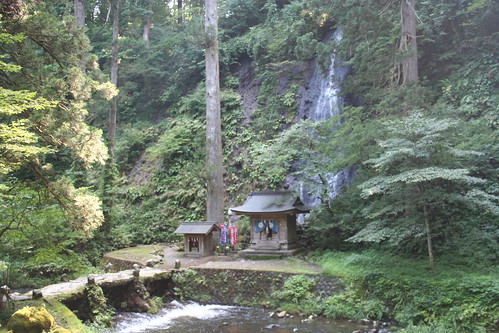 Soon we came to the Go-Jyu-No-To, a wooden five-storied pagoda built in 931 to 937 AD.
Soon we came to the Go-Jyu-No-To, a wooden five-storied pagoda built in 931 to 937 AD. 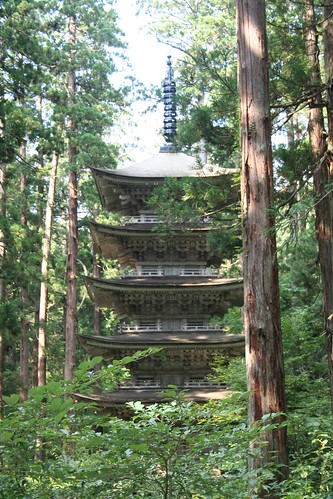 Starting to get used to the idea of climbing stairs (so many more to go!), we kept moving through the forest. We (well, I, really) couldn't help but take a short detour to visit the Minami-Dani (southern valley), the site of a temple built in 1662. Here, the famous haiku poet, Matsuo Basho, stayed while climbing Haguro-san and wrote several haiku. About Minami-Dani, he wrote:
Starting to get used to the idea of climbing stairs (so many more to go!), we kept moving through the forest. We (well, I, really) couldn't help but take a short detour to visit the Minami-Dani (southern valley), the site of a temple built in 1662. Here, the famous haiku poet, Matsuo Basho, stayed while climbing Haguro-san and wrote several haiku. About Minami-Dani, he wrote:So holy a place
The snow itself is scented
At southern valley
Before reaching the summit (414m), we stopped for green tea, and some weird sweet rice goop, at a small tea house on the trail. At the summit, we were awed by the peaceful elegance of the thatched roofed Sanjin Gosaiden. This shrine joins together the three Dewa Sanzen dieties.
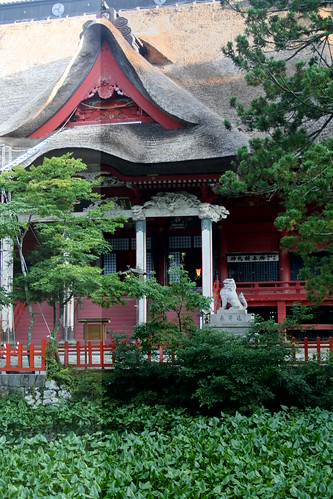 It is a magnificent structure; the 2.1m thick thatched roof supported by a wooden structure is one of a kind. Also on the summit is a monastery, the Kotakuji Temple, a huge bell (from 1275), various other structures, and a very interesting graveyard.
It is a magnificent structure; the 2.1m thick thatched roof supported by a wooden structure is one of a kind. Also on the summit is a monastery, the Kotakuji Temple, a huge bell (from 1275), various other structures, and a very interesting graveyard.  We explored the summit area before walking down a bit to our lodging, the Saikan.
We explored the summit area before walking down a bit to our lodging, the Saikan.  This building used to be a temple called Kozoin, where priests held divine service. Now it is used to provide pilgrims to Dewa Sanzan with accommodation and meals. We were shown our room, a simple grass mat floor room with a low table for tea, and two futon mats on the floor.
This building used to be a temple called Kozoin, where priests held divine service. Now it is used to provide pilgrims to Dewa Sanzan with accommodation and meals. We were shown our room, a simple grass mat floor room with a low table for tea, and two futon mats on the floor. 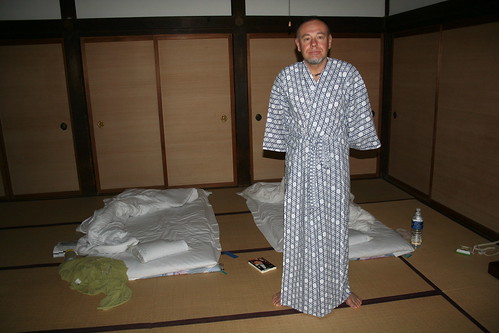 Our meals there were great, we sat on the floor and were served traditional Japanese food on low tables by the monks who lived there.
Our meals there were great, we sat on the floor and were served traditional Japanese food on low tables by the monks who lived there.The next morning, after an early morning walk and a great breakfast, we caught a taxi to the trail head of Gas-san. Gas-san is the highest peak of the Dewa Sanzen, 1984m. It is worshiped as a mountain where our ancestors sleep, and a mountain of fertility that brings rich waters.
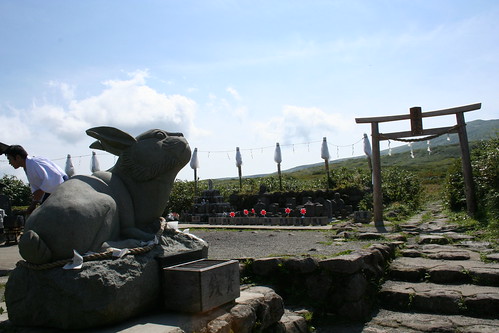 This hike is not stairs, it is a beautiful trail through brush, scattered with peaceful ponds. At the summit is the Gas-san Jinja shrine.
This hike is not stairs, it is a beautiful trail through brush, scattered with peaceful ponds. At the summit is the Gas-san Jinja shrine.  To enter the shrine we had to be purified. We had to bow our heads before the Priest for a blessing, then rub our shoulders, arms, body, legs and feet with sacred paper. Then we dropped the paper in a fountain. We visited the shrine in a foggy mist, then continued down the other side of the mountain toward Yudono-san.
To enter the shrine we had to be purified. We had to bow our heads before the Priest for a blessing, then rub our shoulders, arms, body, legs and feet with sacred paper. Then we dropped the paper in a fountain. We visited the shrine in a foggy mist, then continued down the other side of the mountain toward Yudono-san.We reached the summit of Yudono-san (1504), and continued down the trail until it became a slippery stream bed. Here a series of ladders and chains helped us descend the final stretch to the Yudono-san Jinja.
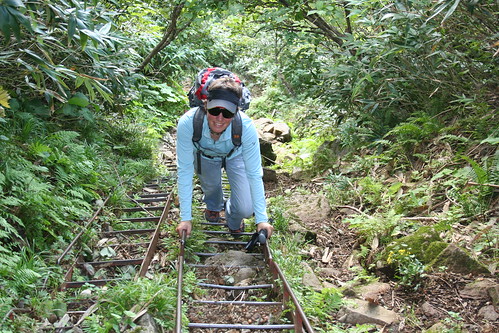 Again here, i was blessed and purified with sacred paper, then instructed to take my shoes off and follow the priest through the shrine. In front of me was a huge orange rock with a hot (and i mean HOT) spring bubbling from pools at it's top. The whole rock was continuously lapped by water from the spring. I am guessing that the rock was formed from precipitates as the hot mineral water bubbled up and over. The rock itself is said to be an embodied deity. The monk told me to walk, clockwise, up the side of the rock, over it's top and back down. The hot water burned my feet as i walked the circle and tried not to slip. At the bottom, the monk rinsed my feet with more of the water, then let me out. Yudono-san Jinja has the strictest rituals of the three mountains.
Again here, i was blessed and purified with sacred paper, then instructed to take my shoes off and follow the priest through the shrine. In front of me was a huge orange rock with a hot (and i mean HOT) spring bubbling from pools at it's top. The whole rock was continuously lapped by water from the spring. I am guessing that the rock was formed from precipitates as the hot mineral water bubbled up and over. The rock itself is said to be an embodied deity. The monk told me to walk, clockwise, up the side of the rock, over it's top and back down. The hot water burned my feet as i walked the circle and tried not to slip. At the bottom, the monk rinsed my feet with more of the water, then let me out. Yudono-san Jinja has the strictest rituals of the three mountains.When I came out of the shrine, Rod was getting frantic... we were late for the last bus back to Tsuruoka. We hiked the last part of the trail to where the parking lot is, and found that yes, we did miss the last bus. What are we going to do?
Presently, the monks from the shrine appear, they have closed up the shrine gate, and are going to drive home. We were so thankful when one of the monks offered us a ride back to the city. We piled into the back of his tiny blue Rav4, and enjoyed talking about mountain biking and listening to Japanese hip-hop the whole ride back.
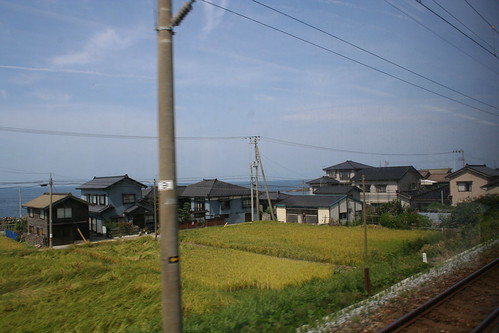 -------
-------That night we stopped in a sushi bar for dinner. Everyone in the bar was so excited to meet some foreigners and practice their English, that pretty soon the whole place was buying sake for each other and toasting the Dewa Sanzen. When we left, we had to shake hands with each person in the restaurant, including the couple who owns it.
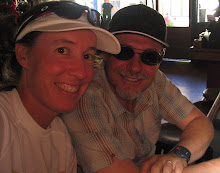
1 comment:
Hi Shelly and Rod,
I found your post on Dewa Sanzan and loved it. It brought back so much wonderful memories. I found it spectacularly enchanting. Thanks for writing it with such concise details. :) My account can be found on my blog.
www.mabletan.com
Till next time fellow travellers!
Cheers,
Mable
Post a Comment